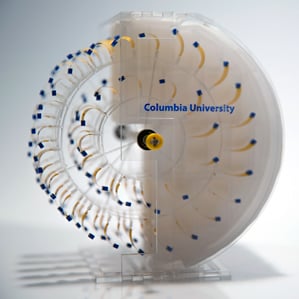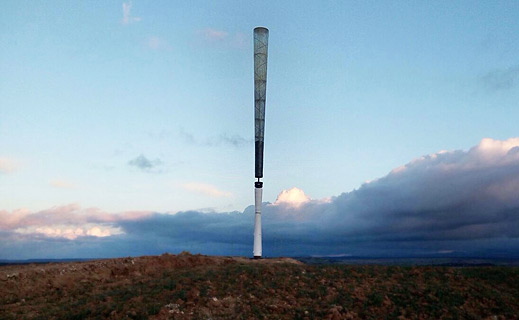|
|
Don't forget to
register for our upcoming Seventh Conference on Future
Energy which gives you the option of two conference
concurrently: www.futurenergy.org.
Registration fee for COFE7 and ExtraOrdinaty Technology grants access
to both conferences at the same time for three full days and two
extra half days. Also, the Embassy Suites Hotel discount conference
rate of $94 per night will expire July 1st.
Never like
being a naysayer since I always look for the silver lining in dim
predictions. Hopefully the silver lining will be an a
ccelerated Future
Energy realization process worldwide. And I mean really accelerated in
five years or less. This month a memo leaked from
Shell
Corporation says that they are preparing
for a 4°C temperature rise (7°F) because
"We do
not see governments taking steps now that are consistent with a 2
The
Guardian). This is also the same 7°F (4°C) temperature rise
indebtedness that IRI predicted back in 2006 based
on Dr. Jim Hansen's graph of CO2 (now
reaching 400 ppm), temperature and sea level and presented at
COFE3 that year and posted on our homepage, updated for 2015. The same
temperature rise has also been confirmed as a likely prediction by
two climate committees in 2012 and now an internal memo from Shell,
along with the IPCC prediction of sea level rise of 5 to 20 meters (
New
Scientist, June 13, 2015, p. 8) expected as West Antarctica ice
collapses rapidly. IRI projects a clean energy breakthrough that will
supplant fossil fuel motors in the next five years and then
geoengineering will be agreed upon to mop up the excess CO2 to bring
it down to pre-industrial levels.
Help us make
it happen since no one group, company, or organization has any
comparable solution and IRI has many.
With Story #1, we revisit the fusion scenario
that keeps looking better at a snail's pace. General Fusion has
emerged with a new era in nuclear fusion with a magnetized target
fusion system creating a vortex they hope will accelerate the hot
plasma fusion process. We hope they are right on target.
Story #2 gives a sunny answer to Saudi oil
fields with the world's largest desalination plant and large
solar photovoltaic (PV) installation farms (see embedded video),
since there has been an 80% decline in manufacturing costs for solar
in the past six years.
Story #3 is a fascinating concept for
a spaceship that can run on sunlight pressure
against a graphene sheet. Of course it is not as powerful asthe Boeing Mach 5 scramjet but
any idea is better than the old rocket engines we are using now, if
we want to colonize Mars for example.
Story #4 expands upon the discovery reported
in our Future Energy eNews, January 2013 from MIT about
a polymer that generates electricity upon evaporating a film
of water on its surface. Now Columbia University is getting
on the bandwagon with tiny rotary or piston engines that turn from
the energy of evaporation. Someday soon the surfaces of bodies of
water will generate electricity without wind or tidal currents.
Our
last Story
#5
is surprising since it is about a wind turbine without blades. Vortex
Bladeless is the name of the company where vibration is the
result of wind energy driving a linear generator with 70% efficiency,
similar to wave energy generators. It seems to be able to handle high
wind speeds too.
Get excited about energy...attend COFE7 and the ExtraOrdinary Technology events
concurrently in the same hotel!
Help IRI be a more effective agent for rapid
change to clean energy...become a member of IRI!
Onward
and Upward,
Sincerely,
Integrity Research Institute
|
|
|
OUR LATEST CONFERENCE
COFE7
JULY 30-AUG 1, 2015
ALBUQUERQUE , NM


Osteoporosis? Our Newest Item
OsteoPad

EM
Pulser
Our best selling PEMF device

PREMIER
Jr.
Our best selling Tesla coil device

|
|
|
1) Has the Holy Grail of Clean Energy been
Found?
|
By Anmar
Frangoul | CNBC Money June 2015
http://www.msn.com/en-us/money/technologyinvesting/has-the-holy-grail-of-clean-energy-been-found/ar-BBkFTej?ocid=iehp

For many,
nuclear fusion is the Holy Grail of energy, offering the possibility
of limitless clean energy through harnessing the very same chemical
reaction that keeps our Sun burning.
While the
potential of fusion is huge, it is a process that requires vast
resources and effort, with the International Energy Agency stating
that, "extreme temperatures and pressure are needed to initiate
and sustain the fusion reaction, making it challenging."
Fusion is
different from the fission power that is used in our nuclear power
stations in that energy is generated when atoms are brought together
rather than blown apart, which causes radiation.
British
Columbia-based General Fusion are hoping that the technology and
methods they are developing will herald a new era in nuclear fusion.
They have developed what they describe as a "Magnetized Target
Fusion system."
According to the
company's website, the system makes use of a sphere which is filled
with molten lead-lithium. This is pumped to create a vortex, into
which 'magnetically confined plasma' -- an electrically charged gas
-- is injected. Pistons surrounding the sphere are used to drive a
wave of pressure into its center, "compressing the plasma to
fusion conditions."

"Fusion is
done... [in] two ways," Michel Laberge, founder and chief
scientist of General Fusion, told CNBC's Sustainable Energy.
"Usually... you make a magnetic field and that hold[s] the
plasma - which is the hot gas - together, or you have no magnetic
field and you crush it very fast with lasers."
"What we
want to do is something in between: we want to make a plasma, a hot
gas, with the magnetic field, and then crush the thing with the
magnetic field, and because [with] the magnetic field the heat will
not escape so fast... that will work a lot better," Laberge
added.
Currently,
General Fusion is developing what they describe as 'full scale
subsystems' that will demonstrate that they can meet performance targets.
In the future, they are hoping to build a full scale prototype which they say will
be, "designed for single pulse testing, demonstrating full net
energy gain on each pulse, a world first."
"Humanity... needs a source of
energy for the future, and we cannot keep on burning fossil
fuels," Laberge said. "Fusion will be powering humanity in
the future," he added.
|
2) The New
Saudi Oil Field: Solar
|
By Mark Dansie, Revolution Green.com June
2015
http://revolution-green.com/category/solar-2/
Saudi oil minister, Ali al-Naimi, is predicting that
within just 25 years we could no longer need fossil fuels.
Solar power will benefit the economy even more than fossil
fuels
Saudi Arabia
finds itself in the fortunate position whereby it can effortlessly
switch from dominating the energy market of the 20th century through
oil to dominating the 21st century with renewables. Al-Naimi believes
that solar power will benefit the economy even more than fossil
fuels. The evidence for this is that global investment in renewables
jumped 16% in 2014, with solar attracting over half the total funding
for the first time, driven by a 80% decline in manufacturing costs
for solar in the last six years.
Saudi Oil wealth
is no doubt a big investor in renewable energy around the world. They
are setting the example in their own country by building the worlds
largest Solar desalination Plant (see second video). Large Solar PV
farms are also being built.
Big Oil and Energy Suppression
This makes a
mockery of people claiming big oil or governments are suppressing
"Free Energy" or anything that may be a threat to oil
consumption. We hear claims that big oil is paying for
"Trolls" with disinformation programs to suppress new
technologies. They have also been accused of buying up technologies
and shelving them. Possibly this may have been the case a few years
ago but not now. They are putting their money where their mouth is. I
privately know of 100 million USD fund from the Middle East available
to develop any disruptive energy technologies. The only catch is you
need to demonstrate your claim as a proof of concept. and they will
use scientist and engineers to verify claims through reputable third
parties. That counts out anything you might see listed at PESWIKI.
(the exception being LENR)
The Saudi
investors are smart. They made there money out of energy and will
continue to do so. The form or source of the energy does not matter,
who owns the infrastructure to supply it does.
|
3) Spaceship built from Graphene
can run on Nothing but Sunlight
|
GRAPHENE to the
stars. The material with amazing properties has just had another
added to the list. It seems these sheets of carbon one atom thick can
turn light into action, maybe forming the basis of a fuel-free
spacecraft.
Graphene was
discovered accidentally by researchers
playing with pencils and sticky tape. Its flat structure is very
strong and conducts electricity and heat extremely well. Yongsheng
Chen of Nankai University in Tianjin, China, and his
colleagues have been investigating whether larger arrangements of
carbon can retain some of these properties. Earlier this year they
published details of a "graphene
sponge", a squidgy material made by fusing crumpled sheets
of graphene oxide.
While cutting
graphene sponge with a laser, they noticed the light propelled the
material forwards. That was odd, because while lasers have been used
toshove
single molecules around , the sponge was a few centimetres
across so should be too large to move. , the sponge was a few centimetres
across so should be too large to move.
The team placed
pieces of graphene sponge in a vacuum and shot them with lasers of
different wavelength and intensity. They were able to push sponge
pieces upwards by as much as 40 centimetres. They even got the
graphene to move by focusing ordinary sunlight on it with a lens.
But how was this
movement happening? One explanation is that the material acts like a solar
sail. Photons can transfer momentum to an object and propel it
forwards, and in the vacuum of space this tiny effect can build up
enough thrust to move a spacecraft. Just last week, the Planetary
Society in Pasadena,
California, launched
a small solar sail to test the technology. But the forces
the team saw were too large to come from photons alone.
The team also
ruled out the idea that the laser vaporises some of the graphene and
makes it spit out carbon atoms.
Instead, they
think the graphene absorbs laser energy and builds up a charge of
electrons. Eventually it can't hold any more, and extra electrons are
released, pushing the sponge in the opposite direction. Although it's
not clear why the electrons don't fly off randomly, the team was able
to confirm a current flowing away from the graphene as it was exposed
to a laser, suggesting this hypothesis is correct (arxiv.org/abs/1505.04254).
Graphene sponge
could be used to make a light-powered propulsion system for
spacecraft that would beat solar sails. "While the propulsion
force is still smaller than conventional chemical rockets, it is
already several orders larger than that from light pressure," they
write.
"The best
possible rocket is one that doesn't need any fuel," says Paulo
Lozano of the Massachusetts Institute of Technology. He
thinks a graphene-powered spacecraft is an interesting idea, but
losing electrons would mean the craft builds up a positive charge
that would need to be neutralised, or it could cause damage.
LightSail Spacecraft Wakes Up Again, Deploys Solar
Sail
|
4) Evaporation
Can Power a Piston or Rotary Engine
|
By Richard Martin, MIT Technology Review, June
2015
http://www.technologyreview.com/news/538571/scientists-capture-the-energy-of-evaporation-to-drive-tiny-engines/?utm_campaign=newsletters&utm_source=newsletter-weekly-energy&utm_medium=email&utm_content=20150622
Harnessing the
power from a fundamental process that's happening constantly, all
over the world, a team of scientists at Columbia University have
devised tiny engines powered by evaporation. The devices generate
electricity from the energy produced by bacterial spores known as Bacillus
subtilis, which exhibit strong mechanical responses to changing
relative humidity.

The spores
expand when they absorb water and contract when they dry out. By
controlling the moisture in the air, produced by evaporation, that
the spores are exposed to, the devices grab the energy of these
expansions and contractions to drive rotary or piston engines. The
research was published on Tuesday in the journal Nature
Communications.
The idea sprang
from research into the mechanical properties of
the subtilisspores, which can exist in a dormant state for
hundreds of years. "It struck me as amazing how much mechanical
energy they seem to have," says Ozgur Sahin, an associate
professor of biological sciences at the university. "They are so
rigid that as the material's shape changes it produces a lot of
energy."
Sahin glued the
spores to a tape made of polyimide-a polymer used in fuel cells,
computer displays, and various military applications-and surrounded
them with a shutter mechanism that controls the passage of moisture.
The shutter is essentially an oscillator, a mechanical switch like an
electrical circuit, that opens and closes in response to the force
produced by the spore changing shape. The opening and closing of the
switch produces the regular pulsing of the swelling and shrinking
spores. When the shutter is open, moisture escapes to the air and the
spore dries out; when it closes, moisture fills the gap, the humidity
increases, and the material expands.
An
eight-centimeter by eight-centimeter water surface can produce about
two microwatts of electricity (a microwatt is one-millionth of a
watt), on average, and can burst up to 60 microwatts, says Sahin.
That doesn't sound like a lot of electricity; so far Sahin and his
team have used the evaporation engines to power an LED and a
miniature car that weighs a tenth of a kilogram.
"We made a
lot of compromises in creating this version in hopes of creating a
self-sufficient device," he says. "We know actually that it
can be made 100 times more powerful by solving a number of
problems."
Those solutions
include adjusting the size of the moisture cavities and the mechanism
of the shutters that control the flow of moisture. Sahin believes
that arrays of the devices on the surface of lakes or other bodies of
water could produce a scalable renewable energy technology, but that
is likely years off, if it ever happens at all. One possible use
could be to create battery-size "bricks" of spores than can
be activated to produce electricity-just add water.
The
tiny engines may have no practical applications in the near term, but
they're still a useful demonstration of the ubiquity of natural
energy that can-at least in theory-be harnessed by relatively simple
and cheap devices.
As
Sahin says, unlike solar and wind power, "Evaporation is not
intermittent."
back to table of contents
|
5) Bladeless
Wind Turbines May Offer more Form than Function
|
By Philip Mckenna, MIT Technology Review, June
2015
http://www.technologyreview.com/news/537721/bladeless-wind-turbines-may-offer-more-form-than-function/?utm_campaign=newsletters&utm_source=newsletter-weekly-energy&utm_medium=email&utm_content=20150601
Startup
Vortex Bladeless makes a turbine that looks intriguing, but it may
not solve wind power's challenges.

Wind power has
become a legitimate source of energy over the past few decades as
larger, more efficient turbine designs have produced ever-increasing
amounts of power. But even though the industry saw a record $99.5
billion global investment in 2014, turbine growth may be reaching its
limits.
Transportation
is increasingly challenging because of the size of the components:
individual blades and tower sections often require specialized trucks
and straight, wide roads. Today's wind turbines are also incredibly
top heavy. Generators and gearboxes sitting on support towers 100
meters off the ground can weigh more than 100 tons. As the weight and
height of turbines increase, the materials costs of wider, stronger
support towers, as well as the cost of maintaining components housed
so far from the ground, are cutting into the efficiency benefits of
larger turbines.
The alternative
energy industry has repeatedly tried to solve these issues to no
avail. But the latest entry promises a radically different type of wind
turbine: a bladeless cylinder that oscillates or vibrates.
Spanish startup
Vortex Bladeless has developed turbines that harness vorticity, the
spinning motion of air or other fluids. When wind passes one of the
cylindrical turbines, it shears off the downwind side of the cylinder
in a spinning whirlpool or vortex. That vortex then exerts force on
the cylinder, causing it to vibrate. The kinetic energy of the
oscillating cylinder is converted to electricity through a linear
generator similar to those used to harness wave energy.
David Yáñez, one
of the company's cofounders, first came across the concept as a
student studying the collapse of the Tacoma Narrows Bridge in
Washington. The bridge collapsed in 1940 due to excessive vibrations
formed by the spinning motion of wind as it blew past the bridge and
is a textbook engineering failure. Yáñez, however, learned a
different lesson. "This is a very good way to transmit energy
from a fluid to a structure," he says.
Vortex's
lightweight cylinder design has no gears or bearings. Yáñez says it
will generate electricity for 40 percent less than the cost of power
from conventional wind turbines. The company has received $1 million
in private capital and government funding in Spain and is seeking
another $5 million in venture capital funding. Yáñez says the company
plans to release a four-kilowatt system in 2016 and a much larger
one-megawatt device around 2018.
The Vortex
turbine sounds promising, but like any radical new alternative energy
design, bladeless turbines have plenty of skeptics.
"If you
have a common propeller-type wind turbine, you have a big area swept
by the blades," says Martin Hansen, a wind energy specialist at
the Technical University of Denmark. "Here you just have a
pole."
In addition to
capturing less energy, oscillating cylinders can't convert as much of
that energy into electricity, Hansen says. A conventional wind
turbine typically converts 80 to 90 percent of the kinetic energy of
its spinning rotor into electricity. Yáñez says his company's
custom-built linear generator will have a conversion efficiency of 70
percent.
Yáñez concedes
that the oscillating turbine design will sweep a smaller area and
have a lower conversion efficiency, but says significant reductions
in manufacturing and maintenance costs will outweigh the losses.
As Vortex builds
bigger devices that catch higher-speed winds further from the ground,
it will also run up against other challenges inherent to the physics
of fluid mechanics. Air or other fluids moving at low speeds past
small-diameter cylinders flow in a smooth, constant motion. Increase
the diameter of the cylinder and the speed at which the air flows
across it, however, and the flow becomes turbulent, producing chaotic
eddies or vortices. The turbulent flow causes the oscillating
frequency of the cylinder to vary, making it difficult to optimize
for energy production.
"With very
thin cylinders and very slow velocities you get singing telephone
lines, an absolutely pure frequency or tone," says Sheila
Widnall, an aeronautics and astronautics professor at MIT. "But
when the cylinder gets very big and wind gets very high, you get a
range of frequencies. You won't be able to get as much energy out of
it as you want to because the oscillation is fundamentally
turbulent."
Widnall also
questions the company's claim that its turbines will be silent.
"The oscillating frequencies that shake the cylinder will make
noise," she says. "It will sound like a freight train
coming through your wind farm."
Oscillating
cylinders are just one of several emerging technologies aimed at
harvesting more of the wind for less. Makani Power is developing a
tethered "energy kite" (see "Flying
Windmills"). It flies in a large circle similar to the tip
of a conventional turbine blade while harnessing wind power via
smaller onboard turbines. Astro Teller, head of Google X, Google's
semi-secret research facility that acquired Makani in 2013, said in
March that the company would soon begin tests of a full-scale,
600-kilowatt kite.
John Dabiri, an
aeronautics and bioengineering professor at Caltech, is testing
different configurations of vertical axis turbines, which are
essentially windmills that spin like a merry-go-round rather than on
a horizontal axis like a bicycle wheel. Typically wind turbines are
placed far apart from each other to optimize energy production. Drawing
on the same principles that fish use to conserve energy by schooling,
Dabiri found that turbines placed close to each other could produce
more energy than those that are far apart.
"You can coӧrdinate
the operation of multiple wind turbines such that the whole is
greater than the sum of its parts," he says.
Dabiri says such
synergistic effects could also apply to conventional, horizontal axis
windmills or even oscillating turbines. The latter pose a greater
challenge because the wake of such turbines is very chaotic but also
a potential benefit because the wake packs a lot of energy, he says.
Much remains to
be seen with Vortex's oscillating turbine, Dabiri says, but he adds
that he is excited by the company's concept. "Anyone who says
the three-bladed turbine is the best we can do is lacking in
vision."
back to table of contents
|
About Integrity Research Institute
Future Energy eNews is
provided as a public service from Integrity Research Institute,
a Non-Profit dedicated to educating the public on eco-friendly
emerging energy technologies.
FREE copy
of the 30 minute DVD "Progress in Future Energy" is
available by sending an email with
"Free DVD" in subject and mailing address in
body.
Your generous support is
welcome by making a tax deductible donation on
our secure website
|
|
|
|
|
|
![]()



















